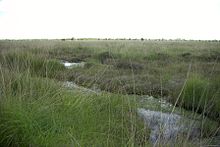
Back Verhewe moeras Afrikaans مغيض Arabic Вярховыя балоты Byelorussian Вярховыя балоты BE-X-OLD Torbera alta Catalan Vrchoviště Czech Cyforgors Welsh Højmose Danish Regenmoor German Pluvmarĉo Esperanto


Raised bogs, also called ombrotrophic bogs, are acidic, wet habitats that are poor in mineral salts and are home to flora and fauna that can cope with such extreme conditions. Raised bogs, unlike fens, are exclusively fed by precipitation (ombrotrophy) and from mineral salts introduced from the air. They thus represent a special type of bog, hydrologically, ecologically and in terms of their development history, in which the growth of peat mosses over centuries or millennia plays a decisive role. They also differ in character from blanket bogs which are much thinner and occur in wetter, cloudier climatic zones.[1]
Raised bogs are very threatened by peat cutting and pollution by mineral salts from the surrounding land (due to agriculture and industry). The last great raised bog regions are found in western Siberia and Canada.
- ^ Whittow, John (1984). Dictionary of Physical Geography. London: Penguin, 1984, p. 438. ISBN 0-14-051094-X.
© MMXXIII Rich X Search. We shall prevail. All rights reserved. Rich X Search